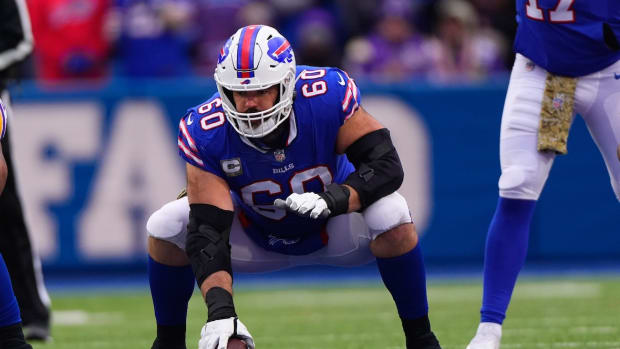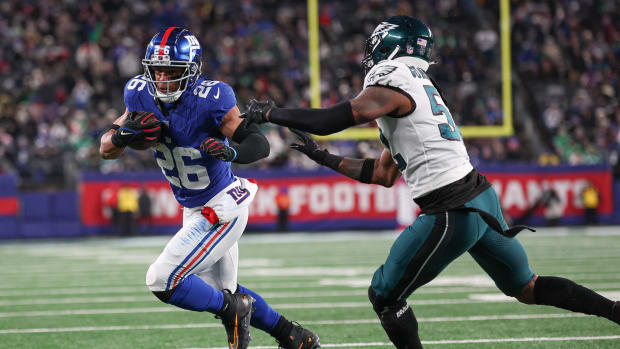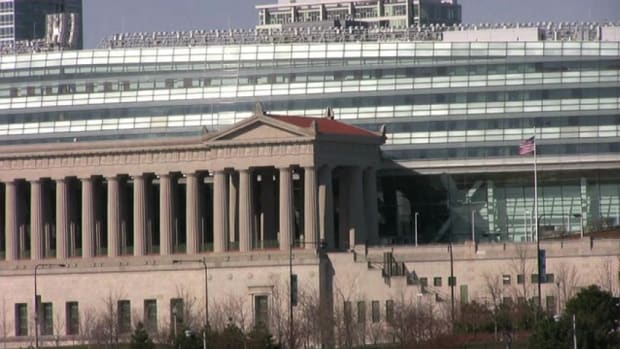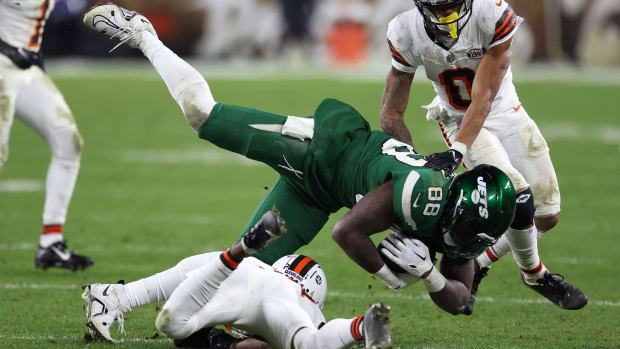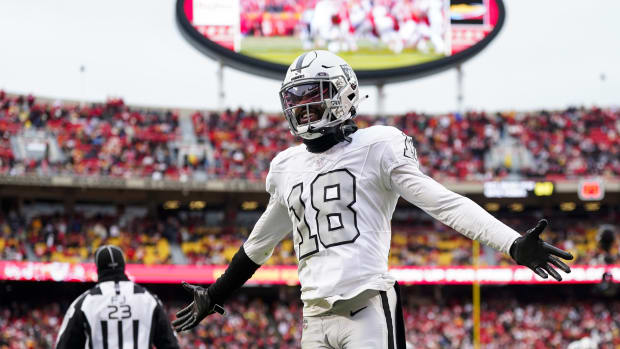Forty-five years after last AFL season, rivalry with NFL still resonates
Long before his transformation into a Hall of Fame legend, broadcasting giant and beloved pop culture figure whose iconic name is recognized by millions, John Madden was just a lightly paid 33-year-old rookie head coach with the 1969 Oakland Raiders, trying to figure out how to keep his job.
He received a valuable piece of advice that summer on how best to go about that, and given that it came from the mouth of a Raiders’ part-owner, he quickly took it to heart. He remembers the marching orders he got that day, and just what it said about the tenor of the times, in that, the last season of the American Football League, before the 1970 AFL-NFL merger occurred and ended the bitter, decade-long war between pro football’s rival leagues.
•NFL Power Rankings Week 11: Who's No. 1? | 2015 NFL Mock Draft
“At that time, Al [Davis] was the Raiders' managing partner, but he had two other general partners -- Wayne Valley and Ed McGah,’’ Madden recalled recently. “So Ed, and Al and I are out to dinner a couple days after I’m named head coach, and this is before cell phones and stuff, so Al had to go make a phone call and excused himself and left just Ed and I sitting at dinner.
“Ed turned to me and said, ‘Look, there’s only one game you have to win, and if you win that game, you’ll always have a job here, and you’ll never have to worry about it. The only game you have to win is the 49ers game. You have to beat the 49ers. You beat the 49ers, and no matter what else happens, you have a job.’ And the thing is, we were only playing them in the preseason. That’s how big it was. It was the AFL versus the NFL. It was Oakland versus San Francisco. Hell, I still feel all that. Those feelings still dominate. We can have a Bay Bridge series in baseball, and I still want the A’s against the Giants."
The All-22: A franchise QB? Andy Dalton is regressing in every facet
This fall marks 45 years since the always colorful, underdog AFL played out its 10th and final season of existence, but Madden isn’t the only one who can still flash back to those days and relive the intensity of that head-to-head competition with the hated NFL, the older, more established, more snobbish of the two professional leagues. Though the AFL-NFL merger had been negotiated and announced in the summer of 1966, three years later the battle still raged, despite the looming truce and the proof of parity between the leagues that the Jets’ Super Bowl III upset of the NFL’s Baltimore Colts provided in January 1969.
For those who coached and played in the AFL, it was almost as if they were foot soldiers near the front, who never received word that the war was over. That reflexive competition, the us-against-them that drove the AFL for a decade, did not diminish and go quietly into the merger season of 1970.
“No, it never did die down, even after the merger was announced,’’ said Madden, whose ’69 Raiders, for the record, beat the 49ers 42-28 in their August exhibition game in Oakland that season. “I mean, Al Davis was the commissioner of the AFL for a bit, and then he came back to Oakland after the merger was negotiated. But he still had that feeling of competition with the NFL in everything. People in Oakland, we knew we were good, and the fans knew we were good. We thought we were as good or better than the NFL. We were treated kind of as second-class citizens, but we never really felt that we should be."
A decade of striving, struggle and accomplishment
Nick Buoniconti lived the AFL-NFL rivalry for the first eight seasons of his 15-year Hall of Fame career, first as a star Boston Patriots' middle linebacker from 1962-68, and then after being traded to the fourth-year expansion Miami Dolphins in 1969, the team he helped lead to Super Bowl greatness in the early ‘70s AFC. The coming merger did nothing to cool the fires of competition with the NFL -- by that point they were too inbred and instinctive to be lessened.
“It was always that the NFL was supposedly far superior to the AFL and we resented that, we certainly did,’’ said Buoniconti, who played eight seasons with Miami, from 1969-76. “There was a bitter rivalry there and even in 1969 you felt like you were carrying the burden of so many players who were in the AFL, or who were past AFL players who weren’t going to be part of the merger and continue to have a roster spot and play in the NFL. You really felt that.
Audibles Podcast: Breaking down the wild-card contenders
“It was us against them, and it even got right down to the separate players associations [the unions]. I was on the executive committee from the AFL, and [Bills quarterback and future U.S. Congressman] Jack Kemp was our leader. He was president of our union. But we used to go to meetings with the NFL union guys, and they were on one half of the room and we were on the other side of the room. It was that bitter, and we ultimately picked [Colts tight end] John Mackey as the leader of the combined union [from 1970-on] because during the merger realignment Baltimore was one of the three NFL teams [along with Cleveland and Pittsburgh] coming into the new AFC."
While the Joe Namath-led 1968 Jets had famously struck the first big blow on behalf of AFL equality by following through on the bravado of Namath's Super Bowl III guarantee over the heavily favored Colts, Buoniconti said one of his most cherished AFL memories came after the league’s final season in ’69, when the Kansas City Chiefs made it two in a row for the upstart league, knocking off Minnesota 23-7 in Super Bowl IV in New Orleans, in January 1970. That ended the four-year AFL-NFL Super Bowl series at 2-2, with the Vince Lombardi Green Bay dynasty having produced wins in the first two games.
“I remember when Lenny Dawson and Kansas City beat the Vikings down in New Orleans in the Super Bowl, I got invited to their team party afterward," Buoniconti said. “And it was not a celebration for the Chiefs themselves as much it was a celebration of the AFL. It was the last game ever for the AFL, and that was an AFL party basically. And then Lenny and I were on Inside the NFL together as hosts for so many years [on HBO], and we’re still AFL guys."
That Chiefs party stood as a celebration of a decade of striving, struggle and accomplishment for the fledgling league, and marked its denouement on the high note that was Super Bowl IV, a game Minnesota entered as a 14-point favorite.
“Nick was absolutely right, because we were a family as the American Football League," said Dawson, the Chiefs Hall of Fame quarterback and still the team’s radio color analyst. “We fought like hell all season long, but we were family when it was all over. I guarantee you Nick and every other guy in the AFL was pulling for the Kansas City Chiefs to beat the Minnesota Vikings in Super Bowl IV. There was jubilation for not only the Chiefs, but for everybody in the AFL. At the end of 1969, we felt -- and by we I mean the entire league -- that we were on the level of the National Football League."
[pagebreak]
"The stupid, step-child of professional football"
Forty-five years out, you can still hear a trace of bitterness in Dawson’s voice. Forgetting one long-ago anecdote that he wanted to relay, he even called back a second time to make sure it was mentioned.
Aaron Rodgers was most mentioned player on Twitter in Week 10
“We had been told for years we were the so-called stupid, step-child of professional football," he said. “They said we weren’t really worthy of the National Football League, and people always pointed toward that in our league. Even if we were playing a preseason game against an NFL team, that was a huge, huge game and we took it very seriously, because we wanted a little respect from not necessarily the fans, but from the teams in the NFL. We wanted to prove we had something to offer."
The Chiefs overwhelmingly proved their point in at least one preseason game against the mighty NFL, during the three years the AFL and NFL scheduled exhibitions against one another in 1967-69. In August 1967, just seven months or so after Kansas City had been outclassed 35-10 by Lombardi’s Packers in the inaugural Super Bowl (though the game didn’t officially go by that moniker until its third installment), the Chiefs played host to the Chicago Bears in the team's first ever preseason game against the rival league.
All week long, Chiefs head coach Hank Stram almost maniacally drilled his team as if he was preparing to meet the Packers for a Super Bowl rematch. Teams played their six exhibition games much more seriously than they do today’s throw-away four-game schedule, but Kansas City's dot-every-I approach that week represented new heights. Largely they were driven by the desire to make some amends for their Super Bowl showing, especially after Lombardi made the cutting postgame comment that “Dallas and several other NFL teams" could have beaten the AFL-best Chiefs that day.
“We remembered it, because Stram was our coach and he reminded us what was said about Super Bowl I," Dawson said. “We took that to heart. We wanted to beat [the Bears] as bad as we possibly could."
Hall of Fame Chiefs linebacker Willie Lanier was a rookie in 1967 and thus did not have to endure the indignity of the Super Bowl loss, but he took note of Stram’s hell-bent determination to make the Bears pay for the disrespect Kansas City incurred.
“I know it was fascinating to watch the preparation for a preseason game, and the interest in not just winning, but winning big," Lanier said. “The score of that game against the Bears was 66-24, in our favor, and it was just wanting to show whenever possible that the team had the ability to compete. Since you didn’t have interconference play until 1970, the only place you could play the NFL was in the preseason games.
First Down/Fourth Down: Best may still be to come for Browns
“I remember that game against the Bears, Stram played our starters almost the whole way. [Linebacker] Jim Lynch and I were rookies together that year, and I’m sure we didn’t play until late in the fourth quarter. It was all about trying to show the NFL teams that you were equal or even better than they were."
Up to that point, it was the largest margin of defeat the tradition-rich Bears had ever experienced, and Chicago, still coached by the legendary George Halas, was shell-shocked by the drubbing. As Dawson recalled in an excellent 1995 HBO documentary about the AFL-NFL rivalry, famed Bears middle linebacker Dick Butkus that night expressed mock concern for the health of the Chiefs’ popular horse and mascot “War Paint,’’ who was ridden the length of the field every time Kansas City scored in those days. The horse, Dawson said, survived the leagues’ rivalry.
Current Jets head coach Rex Ryan was a 6-year-old son of Jets defensive coordinator Buddy Ryan in 1969. Even as defending Super Bowl champions that season, the Jets were disdainful of all things NFL, and Rex Ryan grew up hearing about a Jets-Giants preseason game that took on an inflated meaning in the latter stages of the two leagues’ battle for football supremacy.
“It’s a great story and I’ve talked to former Jets players about it, because it’s amazing," Ryan said this year in training camp. “So the Jets win the Super Bowl in January 1969, but somehow they still weren’t regarded as the top team in football or anything like that. But the next preseason, for the first time ever, they play the [NFL’s] Giants, and they win the thing [37-14, in the Yale Bowl in New Haven, Conn.].
“The Jets go nuts. They celebrated that game like they won the Super Bowl all over again. It’s just one of those things. It was us versus them. David versus Goliath, all that kind of jazz. They thought after they won the Super Bowl they would get the credit they deserved. Well they didn’t. So even though it was a preseason game, they put that much into it and it meant that much to them. But it’s the truth. They knew they had a certain fight to have with the NFL, and they had to win that fight. And obviously the NFL now is the benefactor."
“How does that lousy American Football League look now?’’
Lanier said the brotherhood that was the AFL was so strong that when Namath and the Jets broke through on behalf of the league in Super Bowl III, beating the Colts 16-7 after Baltimore had been a 17-point pregame favorite, he along with Chiefs defensive teammates Buck Buchanan and Emmitt Thomas spontaneously made a pilgrimage of sorts to the Jets team hotel in Fort Lauderdale that very night. The next day, all three Chiefs were due to report to Jacksonville, for the AFL All-Star Game that would be held at the Gator Bowl the following Sunday.
“We didn’t plan to, but after the Jets won, the three of us decided we had to be there," Lanier said. “We had to get to the Galt Ocean Mile Hotel, hoping to see some Jets players," Lanier said. “We were excited to see the Jets win, and Namath, as all of us remember, saw the three of us as he got off the team bus. He came over and we hugged, and he made sure he allowed us to congratulate him for having beaten the Colts, for having been the first AFL team to do that.
“And lo and behold, the next year it was us, and it was basically the same kind of thing, as the league and all the players appreciated the fact that the Chiefs were able to be the team that won and ended the Super Bowl series 2-2. It really established the fact that, ‘Yes, the AFL could definitely play toe to toe against the NFL.'"
Dawson recalls being in the stands in the Orange Bowl for Super Bowl III, with a group of fellow AFL and NFL players who were there as guests of American Express. The Chiefs' quarterback said he knew he was outnumbered and largely surrounded by NFL backers that day, so he bit his lip and bided his time until Namath’s historic guarantee was close to coming to fruition. Then the dam burst, and years of AFL inferiority talk got swept away with it.
“I’m sitting quietly in the stands, keeping my mouth shut until I couldn’t stand it any longer," Dawson said. “At some point in the fourth quarter, when I knew the Jets were going to win, I spoke up and said, ‘How does that lousy American Football League look now?’ I just had to stick it in, because I had been holding it in all day."
Don Shula was on the wrong side of history that tide-turning day in the Orange Bowl. The sixth-year Baltimore head coach led the mighty 15-1 Colts into that game, but then found out first hand how the balance of power had shifted to the still-young AFL, represented by Namath and the Jets.
“It was pretty tough being the first team and the first coach to lose to the AFL," said Shula, who went on to join the former AFL’s Miami Dolphins as head coach in 1970, in the newly merged league. “When the Jets beat us in Super Bowl III, that brought them a lot closer to us in terms of the relative strength of the competitive relationship. But then the next year it happened again with Kansas City beating Minnesota and that really made people realize just a little bit more about how equal the leagues were at that point.
“It did take quite a while for those competitive instincts between the leagues to die down. The two leagues just had their own personalities and their own set of coaches and players, and they both took great pride in their teams and their accomplishments. Then the merger came and everybody was together playing each other, and it just made it that much more interesting of a game."
Forty-five years have passed since the AFL’s final chapter was playing out in 1969, and a 10-team renegade league became a 13-team AFC in 1970, matching the 13-team NFC, all under the NFL umbrella. The Colts, one of the three NFL franchises transferred to the new AFC for balance, won Super Bowl V in January 1971, beating Dallas on Jim O’Brien’s last-second field goal. The AFL-NFL war was over, and a seismic shift had occurred in professional football.
“After that AFL-NFL battle ended, I think things changed somewhat in the AFC and NFC, because guys were moving around from team to team, and somebody on Kansas City’s team one year would join some former NFL team the next year," Dawson said. “It couldn’t be the same, and it wasn’t.
“But my question has always been, what would football been like today if that didn’t happen? If that rivalry between the AFL and NFL didn’t exist? Because that league was successful -- our league, the AFL -- pro football was more successful. Look at the league now. It changed the game. That rivalry changed the game."




































